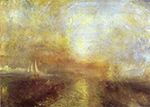Yet How Communicate?
"This reticence--this isolation--that's what's
the matter with modern life!" (75).
Virginia Woolf's The Voyage Out (1915)
Points for Reflection
"Phyllis and Rosamond" (1906), pp.17-29
- The narrator suggests that what personality type in women best suits studying social problems, and that what other sort is better relegated to the domestic sphere?
- Which of the two sisters who remains home instead of attending university is the leader, the older Phyllis or younger Rosamond? Why?
- What characteristic do the sisters value most in men?
- In Bloomsbury, an "unfashionable quarter of London," the sisters discover what which they think they could never have for themselves?
The Voyage Out (1915), chps. 1-10
- does Woolf allow humor to temper the emotional seriousness of this novel?
- does what we learn later in the novel about Mr. and Mrs. Ambrose—their personalities, proclivities, and marriage—complement the portrait of them provided in the novel’s opening pages?
- do Helen Ambrose’s initial assumptions about Rachel gel with what the reader discovers about Rachel via the narrator?
- as described by the narrator, is sea travel enviable?
- what form has Rachel’s education taken, and what drawbacks and benefits does the narrator attribute to this type of schooling?
- how much satisfaction has Rachel found in life?
- The Dalloways represent a certain segment of society, socially and ideologically. What attitude does Woolf implicitly adopt towards this class: what tone dominates her sketch of these characters?
- do Clarissa’s opinions mirror her husband’s?
- does the novel encourage us to validate the Dalloways’ view of Art? Are we implicitly directed to either agree or disagree with their perspective?
- why might Sophocles’ Antigone haunts Clarissa Dalloway (45)?
- what attributes in Clarissa Dalloway attract Rachel Vinrace’s affection?
- are the Dalloways in love?
- what about Richard so intrigues Rachel prior to chp. 5?
- is Richard Dalloway correct when he claims that Clarissa’s “‘illusions have not been destroyed’” (65)? Has she achieved that happiness she identifies as “‘the only thing that counts’” (59)?
- does Richard’s confession to Rachel about human communication echo her own confession to Clarissa earlier?
- does Mr. Dalloway’s opinion about Rachel’s appearance mirror the opinions of Clarissa and Helen?
- what do Rachel’s dreams reveal about her fears and desires, and do they reflect her waking thoughts?
- is Helen Ambrose the wisest character in the novel, or does she have notable lacunae in her perceptions?
- what is Helen Ambrose’s attitude towards sex?
- just because Helen often thinks Rachel foolish, should the reader also?
- what suddenly resolves Rachel’s mixed feelings about Richard into the declaration that “‘I hate men!’” (82)?
- does Helen Ambrose write off Clarissa Dalloway too quickly as a “thimble-pated creature” (82). Is Clarissa’s nature deeper than Helen recognizes?
- Helen’s strategy for re-educating Rachel about “how to live” (83) involves what, exactly?
- does Willoughby Vinrace imagine his daughter getting married?
- does everyone react similarly to their landing in Santa Marina, somewhere in South America?
- what might Helen’s letter contain to which the reader is not allowed access (96)?
- does the conversation held by the hotel guests seem inane compared with that held earlier by the travelers on the Euphrorsyne?
- does Hirst’s wit fall flat with others?
- how has Rachel’s reading copiously for three months altered her response to life?
- what deep thoughts war with Hewet’s optimism?
- do any of the various perspectives on poverty voiced in the opening chapters seem to be implicitly validated by Woolf herself?
- can you unearth Woolf's own point of view concerning England amidst all the opinions bandied about by the characters?

Yacht Approaching
Coast (1835)
J. M. W. Turner
Dr. Paul Marchbanks
pmarchba@calpoly.edu
